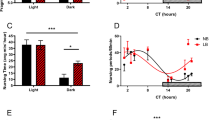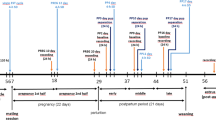Abstract
THE factors determining the onset of labour are largely unknown, though the regulating mechanisms seem to originate from both the foetus and the mother. The foetus seems to determine the day of birth, through the maturation of the pituitary–adrenal–placental axis, but the mother may provide a fine control, determining the precise hour of birth. Labour varies greatly in its timing and speed of execution, presumably as the result of selection to ensure the maximum probability of survival of both the mother and offspring. Environmental factors such as light, tides and predators are of great importance, providing cues which influence the final hour of birth. Even women, who during childbirth are confined in a most artificial environment, show a marked tendency to deliver in the early hours of the morning1–4.
This is a preview of subscription content, access via your institution
Access options
Subscribe to this journal
Receive 51 print issues and online access
$199.00 per year
only $3.90 per issue
Buy this article
- Purchase on Springer Link
- Instant access to full article PDF
Prices may be subject to local taxes which are calculated during checkout
Similar content being viewed by others
References
King, P. D., Science, 123, 985–986 (1956).
Kaiser, I. H., and Halberg, F., Ann. N. Y. Acad. Sci., 98, 1056–1068 (1962).
Malek, J., Gleich, J., and Maly, V., Ann. N. Y. Acad. Sci., 98, 1042–1055 (1962).
Conroy, R. T. W. L., and Mills, J. N., Human Circadian Rhythms, 112–114 (Churchill. London, 1970).
Everett, J. W., Sawyer, C. H., and Markee, J. E., Endocrinology, 44, 234–250 (1949).
Yoshinaga, K., Hawkins, R. A., and Stocker, J. F., Endocrinology, 85, 103–112 (1969).
Wiest, W. G., Endocrinology, 87, 43–48 (1970).
Waynforth, H. B., and Robertson, D. M., J. Endocr., 54, 79–85 (1972).
Bast, J. D., and Melampy, R. M., Endocrinology, 91, 1499–1505 (1972).
Waynforth, H. B., Pope, G. S., and Hoskin, Z., J. Reprod. Fert., 28, 191–196 (1972).
Labhsetwar, A. P., and Watson, D. J., Biol. Reprod., 10, 103–110 (1974).
Pepe, G. J., and Rothchild, I., Endocrinology, 95, 275–297 (1974).
Boer, K., Lincoln, D. W., and Swaab, D. F., J. Endocr., 65, 163–176 (1975).
Mitchell, J. A., and Yochim, J. M., Endocrinology, 87, 472–480 (1970).
Svorad, D., and Sa´chova´, V., Physiologia bohemoslow, 8, 439–442 (1959).
Porter, D. G., J. Reprod. Fert., 28, 9–14 (1972).
Halberg, F., A. Rev. Physiol., 31, 675–725 (1969).
Fuchs, A-R., Biol. Reprod., 1, 344–353 (1969).
Fuchs, A-R., and Poblete, V. F., Biol. Reprod., 2, 387–400 (1970).
Author information
Authors and Affiliations
Rights and permissions
About this article
Cite this article
LINCOLN, D., PORTER, D. Timing of the photoperiod and the hour of birth in rats. Nature 260, 780–781 (1976). https://doi.org/10.1038/260780a0
Received:
Accepted:
Published:
Issue Date:
DOI: https://doi.org/10.1038/260780a0
Comments
By submitting a comment you agree to abide by our Terms and Community Guidelines. If you find something abusive or that does not comply with our terms or guidelines please flag it as inappropriate.



